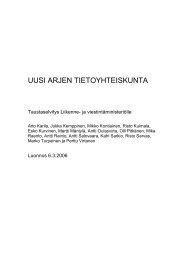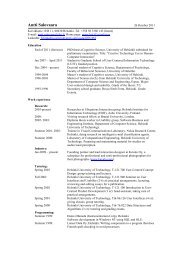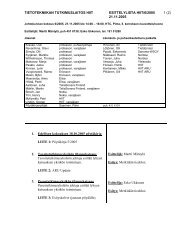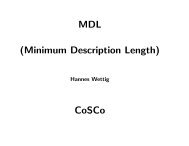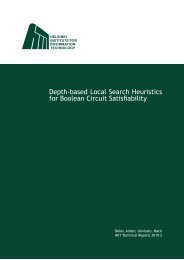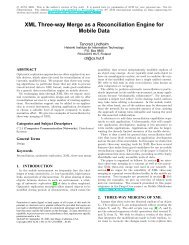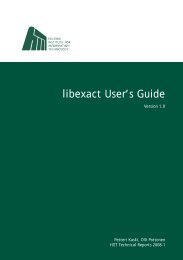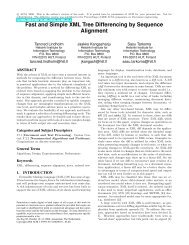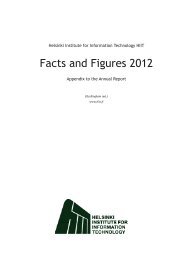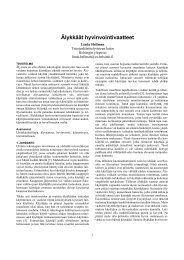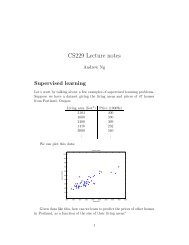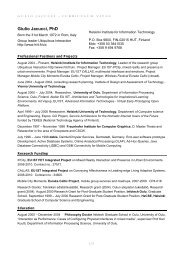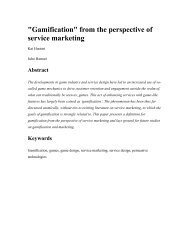Comparison of EndâUser Electric Power Meters for Accuracy
Comparison of EndâUser Electric Power Meters for Accuracy
Comparison of EndâUser Electric Power Meters for Accuracy
Create successful ePaper yourself
Turn your PDF publications into a flip-book with our unique Google optimized e-Paper software.
<strong>Comparison</strong> <strong>of</strong> End‐User <strong>Electric</strong><br />
<strong>Power</strong> <strong>Meters</strong> <strong>for</strong> <strong>Accuracy</strong><br />
Liikkanen, Lassi A. 1 and Nieminen, Tatu 2<br />
1<br />
Helsinki Institute <strong>for</strong> In<strong>for</strong>mation Technology HIIT,<br />
Helsinki University <strong>of</strong> Technology TKK<br />
PO Box 9800, 02015 TKK, Finland<br />
2<br />
Department <strong>of</strong> <strong>Electric</strong>al Engineering,<br />
Helsinki University <strong>of</strong> Technology TKK<br />
PO Box 3000, 02015 TKK, Finland<br />
E‐mails: 1 <strong>for</strong>ename.surname@hiit.fi, 2 <strong>for</strong>ename.surname@tkk.fi<br />
Abstract. In the present study, we investigated the technical qualities <strong>of</strong> power<br />
consumption meters. A selection <strong>of</strong> nine meters available at general electric and<br />
discounts stores was selected <strong>for</strong> an evaluation along with two more expensive<br />
products and one prototype meter. The majority <strong>of</strong> the af<strong>for</strong>dable devices fell into<br />
the price range <strong>of</strong> 10‐20 Euros. In the test, variable load combinations were used to<br />
asses the meters in reference to a known, calibrated power quality measurement<br />
device. The loads included small and reactive loads estimated to be difficult <strong>for</strong> the<br />
meters. The accuracy <strong>of</strong> the measured devices was very variable, some meters<br />
qualifying with small resistive loads, the majority <strong>of</strong> meters with high resistive<br />
loads. The found inaccuracies were predominantly negative. The devices<br />
underestimated the consumption and some devices had more than 25% error. In this<br />
report we document these measurements and reveal the relative qualities <strong>of</strong> the<br />
tested products, highlighting two products.<br />
Keywords: power consumption meters, electrict power meter, accuracy, usability<br />
1. Introduction<br />
In 2009 the European Commission has just recently released a new climate and<br />
energy package (European Parliament, 2008). This act has been discussed in length<br />
in several media, along with other anti‐climate change maneuvers. Together these<br />
timely debates draw the attention <strong>of</strong> European citizens into energy issues. When<br />
ecological awareness comes coupled with the increasing trend in electricity prices<br />
in Northern‐Europe, an incentive may arise <strong>for</strong> consumers to think more carefully<br />
about their electricity consumption. Recent study shows economical incentives are<br />
the primary reason why people take action (see, Liikkanen, 2009). One <strong>of</strong> these<br />
actions is to seek out in<strong>for</strong>mation about how much electricity is consumed by<br />
different household appliances. This can be achieved using electric power meters.<br />
People may be interested to find out do they possess a defective device, or be<br />
1



